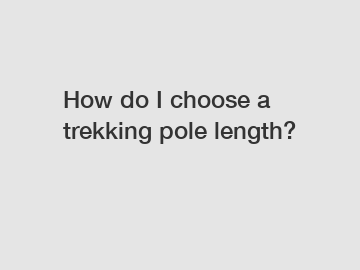How do I choose a trekking pole length?
How do I choose a trekking pole length?
Trekking poles are becoming increasingly popular among outdoor enthusiasts, as they offer stability, reduced strain on joints, and added support while hiking or trekking. However, choosing the right trekking pole length is crucial for maximizing its benefits. Selecting the appropriate length ensures proper technique, comfort, and overall ease of use. This article will guide you on how to choose the ideal trekking pole length for your adventures.
Primary Factors to Consider.

When selecting the correct trekking pole length, there are several primary factors to assess, including your height, terrain type, and personal preference. These factors play a crucial role in determining the suitable length that enhances your balance, stability, and overall trekking experience.
Height.
Your height is one of the fundamental aspects to consider when choosing a trekking pole length. As a general rule of thumb, taller individuals will require longer poles compared to shorter individuals. Most trekking poles are adjustable, allowing you to customize the height based on your needs. A simple technique to determine the right length is by standing upright and holding the pole vertically. Adjust the pole until your forearm is parallel to the ground and forms a 90-degree angle with your upper arm. This position ensures optimal support and helps distribute the weight evenly.
Terrain Type.
The type of terrain you primarily trek on also affects the ideal trekking pole length. For flat or slightly inclined surfaces, shorter poles are recommended to provide balance and reduce strain on joints. Longer poles, on the other hand, are beneficial for hikers tackling steep and challenging terrains, offering extra stability and serving as an aid during ascents and descents. Assessing your typical hiking environments is essential for determining the appropriate length for your trekking poles.
Personal Preference.
Personal preference is another vital aspect to consider when choosing trekking pole length. Some individuals may prefer longer poles for increased stability and support, while others may opt for shorter poles to prioritize ease of use and maneuverability. Experimenting with different lengths can help you identify the ideal size that aligns with your specific preferences and trekking style.
Secondary Factors to Consider.
In addition to the primary factors mentioned above, there are a few secondary considerations that can further assist you in choosing the suitable trekking pole length.
Pack Weight.
If you often carry heavy backpacks during your treks, longer poles might prove advantageous. The additional length helps offset the load, providing enhanced stability and balance. Conversely, if you generally travel light, shorter poles may be preferred for their convenience and maneuverability.
Activity Type.
Different activities require various pole lengths. For example, if you engage in backpacking or fast-paced hiking, shorter poles are recommended to complement your stride and maintain an efficient pace. On the other hand, if your adventures involve mountaineering or winter trekking, longer poles are preferred due to the need for more stability in challenging conditions.
Closing Thoughts.
Choosing the right trekking pole length depends on several factors, including height, terrain type, personal preference, pack weight, and activity type. By considering these elements, you can determine the ideal trekking pole length that suits your needs and enhances your outdoor exploration. If you still have questions or require additional guidance, feel free to contact us for expert advice. Happy trekking!
*Contact us for expert advice on trekking poles and find the perfect fit for your treks!
Contact us to discuss your requirements of Versatile Camp Bed, Aluminum Folding Beach Chair Wholesale, Beach Chair Manufacturers. Our experienced sales team can help you identify the options that best suit your needs.

Comments